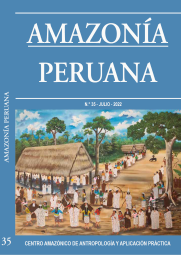Sobre el canto mágico, las perspectivas sonoras, las multinaturas ambientales y la experiencia consciente
DOI:
https://doi.org/10.52980/revistaamazonaperuana.vi35.297Palavras-chave:
Shipibo-konibo, Animismo, Perspectivismo, PerúResumo
Hasta ahora la importancia de lo sónico, especialmente la música vocal, en el contexto del animismo y el perspectivismo ha sido subestimada en la teoría antropológica. Basandose en ejemplos de canciones mágicas de los shipibo-konibo extraídas de grabaciones etonomusicológicas propias del trabajo del campo del autor, se propone en este artículo que la experiencia en primera persona de médicos (curanderos o brujos) debe ser considerada de altísimo valor para la interpretación de las estructuras de ralaciones entre humanos y no humanos. Esta experiencia surge de manera más evidente en los estilos de canto y las letras de las canciones interpretadas por los médicos en el estado de interacción con los no humanos durante la curación, la adoración o la lucha rituales. Los resultados obtenidos de este análisis incluyen...
Downloads
Referências
Brabec de Mori, B. (2009). Words can doom. Songs may heal: Ethnomusicological
and indigenous explanations of song-induced transformativeprocesses in Western
Amazonia. Curare. Journal for Medical Anthropology 32(1+2): 123-144.
Brabec de Mori, B. (2011a). The magic of song, the invention of tradition and
the structuring of time among the Shipibo (Peruvian Amazon). Jahrbuch
des Phonogrammarchivs der O¨sterreichischen Akademie der Wissenschaften 2:
-192.
Brabec de Mori, B. (2011b). Tracing hallucinations. Contributing to a critical
ethnohistory of ayahuasca usage in the Peruvian Amazon. En Labate,
Beatriz Caiuby & Henrik Jungaberle (eds.): The Internationalization of
Ayahuasca. Zu¨rich: LIT, 23-47.
Brabec de Mori, B. (2013): Shipibo Laughing Songs and the Transformative
Faculty: Performing or Becoming the Other. Ethnomusicology Forum
(3): 343-361.
Brabec de Mori, B. (2015). Die Lieder der Richtigen Menschen. Musikalische
Kulturanthropologie der indigenen Bevo¨lkerung im Ucayali-Tal, Westamazonien
[incluye DVD]. Innsbruck: Helbling academic books.
Brabec de Mori, B. (2018). ‘The Inka´s Song Emanates from my Tongue’:
Learning and Performing Shipibo Curing Songs. En Aharonián, Coriun
(ed.), La música y los pueblos indígenas, pp. 73–107. Montevideo: Centro
de Documentación Musical.
Brabec de Mori, B. y Silvano de Brabec, L. (2009). La corona de la inspiracio´n.
Los disen~os geome´tricos de los Shipibo-Konibo y sus relaciones con cosmovisio´n
y mu´sica. Indiana 26: 105-134.
Camacho, J. y Eli´as-Ulloa, J. (2005). The syntactic structure of evidentiality in
Shipibo (<http://www.hmn.bun.kyoto-u.ac.jp/langlogic/symposium-a/
abstracts/CamachoAbstract.pdf >; 30.03.2022).
Canayo, L. (2004). Los duen~os del mundo shipibo. Lima: Centro de Produccio´n
Editorial e Imprenta, Universidad Nacional Mayor de San Marcos.
Classen, C. (2005). McLuhan in the rainforest: The sensory worlds of oral
cultures. En Howes, David (ed.): Empire of the senses: The sensual culture
reader. New York: Berg, pp. 147-163.
Descola, P. (2005). Par-dela` nature et culture. Paris: Gallimard.
Frank, E. (1994). Los uni. En Santos-Granero, Fernando & Federica Barclay
(eds.): Guia Etnogra´fica de la Alta Amazoni´a. Vol. II. Quito: Facultad Latinoamericana
de Ciencias Sociales (FLACSO), pp. 129-238.
Gow, P. (1994). River people: Shamanism and history in Western Amazonia.
En Thomas, Nicholas & Caroline Humphrey (eds.): Shamanism, history
and the state. Ann Arbor: University of Michigan, pp. 90-113.
Hill, J. (1993). Keepers of the Sacred Chants. The Poetics of Ritual Power in an
Amazonian Society. Tucson/London: The University of Arizona Press.
Illius, B. (1987). Ani Shinan. Schamanismus bei den Shipibo-Conibo (Ost-Peru).
Ethnologische Studien, 3. Tu¨bingen: S&F.
Illius, B. (1992). The concept of Nihue among the Shipibo-Conibo of Eastern
Peru. En Langdon, E. Jean & Gerhard Baer (eds.): Portals of power. Shamanism
in South America. Albuquerque: University of New Mexico Press, pp. 63-78.
Illius, B. (1997). Ein Lied zur Haarschneidezeremonie der Shipibo-Conibo.
En Du¨rr, Eveline & Stefan Seitz (eds.): Religionsethnologische Beitra¨ge zur
Amerikanistik. Ethnologische Studien, 31. Mu¨nster: LIT, pp. 211-231.
Illius, B. (1999). Das Shipibo. Texte, Kontexte, Kommentare. Ein Beitrag zur
diskursorientierten Untersuchung einer Montan~a-Kultur. Berlin: Dietrich Reimer.
Karadimas, D. (2004). The Miran~a deer skull: Mythological and cognitive implications
of a Miran~a communication instrument (Colombian Amazon). En Myers, Thomas
P. & Mari´a Susana Cipolletti (eds.): Artifacts and society in Amazonia/Artefactos y
sociedad en la Amazoni´a. Bonner AmerikanistischeStudien, 36. Bonn: Bonner
Amerikanistische Studien (BAS), pp. 63-94.
Karadimas, D. (2012). Animism and perspectivism: Still anthropomorphism?
On the problem of perception in the construction of Amerindian ontologies.
Indiana 29: 25-51.
Latour, B. (2009). Perspectivism: ‘Type’ or ‘bomb’? Anthropology Today, 25(2): 1-2.
LeClerc, Fre´de´rique Rama. (2003). Des modes de socialisation par les plantes chez
les Shipibo-Conibo d ´amazonie peruvienne. Une e´tude des relations entre humains
et non-humains dans la construction sociale. PhD thesis, Laboratoire
d’ethnologie et de sociologie comparative, Universite´ Paris X - Nanterre.
Lehrer, K. (2006). Consciousness, representation and knowledge. En Kriegel,
Uriah & Kenneth Williford (eds.): Self-representational approaches to consciousness.
Cambridge: MIT, pp. 409-420.
Lewy, M. (2012). Different “seeing” – similar “hearing”. Ritual and sound among
the Pemón (Gran Sabana/Venezuela). Indiana 29: 53-71.
Menezes Bastos, R. de. (2007). Music in the indigenous societies of lowland
South America: The state of the art. Mana N.S. 3 (
scielo.org/scielo.php?script=sci_arttext&pid=S0104-93132007000100001>;
03.2022).
Menezes Bastos, R. de. (2013). Apùap World Hearing Revisited: Talking with
‘Animals’, ‘Spirits’, and Other Beings, and Listening to the Apparently
Inaudible. Ethnomusicology Forum 22(3): 287-305.
Nagel, T. (1974). What is it like to be a bat? Philosophical Review 83(4): 435-450.
Ochoa Abaurre, J. (2002). Mito y chamanismo: el mito de la tierra sin mal en los
tupi´-cocama de la Amazoni´a peruana. PhD thesis, Facultad de Filosofi´a,
Universidad de Barcelona.
Olsen, D. (1996). Music of the Warao of Venezuela. Song people of the rain forest.
Gainesville: University Press of Florida.
Rosengren, D. (2006). Matsigenka corporeality, a nonbiological reality: On
notions of consciousness and the constitution of identity. Tipiti´. Journal
of the Society for the Anthropology of Lowland South America 4(1+2): 81-102.
Santos-Granero, F. (2003). Pedro Casanto’s Nightmares: Lucid dreaming in
Amazonia and the New Age movement. Tipiti´. Journal of the Society for
the Anthropology of Lowland South America 1(2): 179-210.
Santos-Granero, F. (2006). Sensual vitalities: Noncorporeal modes of sensing
and knowing in native Amazonia. Tipiti´. Journal of the Society for the Anthropology
of Lowland South America 4(1+2): 57-80.
Seeger, A. (1987). Why Suya´ sing. A musical anthropology of an Amazonian people.
Cambridge Studies in Ethnomusicology. Cambridge: Cambridge University
Press.
Seth, A. (2007). Models of consciousness. Scholarpedia 2(1): 1328 (
www.scholarpedia.org/article/Models_of_consciousness>; 30.03.2022).
Stoltze Lima, T. (1999). The two and its many: Reflection on perspectivism in
a Tupi cosmology. Ethnos 64(1): 107-131.
Taussig, M. (1993). Mimesis and alterity. A particular history of the senses. New
York/London: Routledge.
Tournon, J. (2002). La merma ma´gica. Vida e historia de los Shipibo-Conibo del
Ucayali. Lima: Centro Amazo´nico de Antropologi´a y Aplicacio´n Pra´ctica(CAAAP).
Turner, T. (2009). The crisis of late structuralism. Perspectivism and animism:
Rethinking culture, nature, spirit, and bodiliness. Tipiti´: Journal of the Society
for the Anthropology of Lowland South America 7(1): 3-40.
Valenzuela, P. (2003). Evidentiality in Shipibo-Konibo, with a comparative
overview of the category in Panoan. En Aikhenvald, Alexandra Y. & Robert
M. W. Dixon (eds.): Studies in evidentiality. Amsterdam: John Benjamins,
pp. 33-61.
Velmans, M. (2009). How to define consciousness – and how not to define
consciousness. Journal of Consciousness Studies 16(5): 139-156.
Vilac¸a, A. (2005). Chronically unstable bodies: Reflections on Amazonian corporalities.
Journal of the Royal anthropological Institute N.S. 11: 445-464.
Viveiros de Castro, E. (1997). Die kosmologischen Pronomina und der indianische
Perspektivismus. Bulletin de la Socie´te´ Suisse des Ame´ricanistes 61: 99-114.
Viveiros de Castro, E. (2010). The forest of mirrors. A few notes on the ontology
of Amazonian spirits (<http://amazone.wikia.com/wiki/The_Forest_of_Mirrors>; 30.03.2022).
Windt, J. y Noreika, V. (2011). How to integrate dreaming into a general theory
of consciousness - a critical review of existing positions and suggestions
for future research. Consciousness and Cognition 20(4): 1091-1107.
Downloads
Publicado
Edição
Seção
Licença

Este trabalho está licenciado sob uma licença Creative Commons Attribution 4.0 International License.
















 Av. González Prada 626, Magdalena del Mar
Av. González Prada 626, Magdalena del Mar